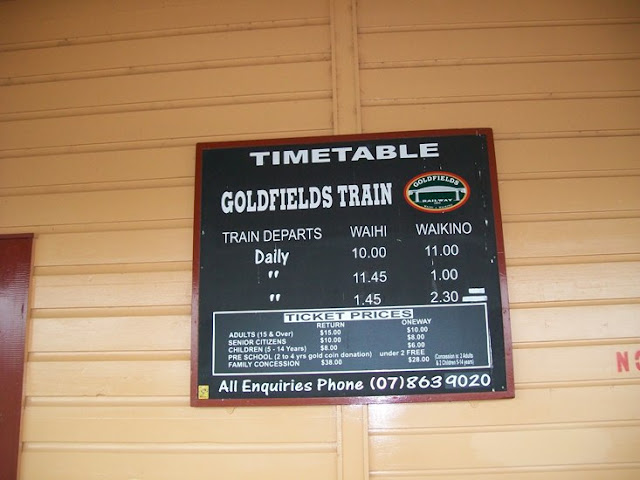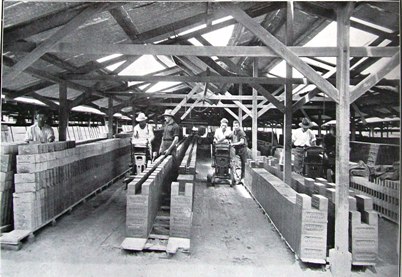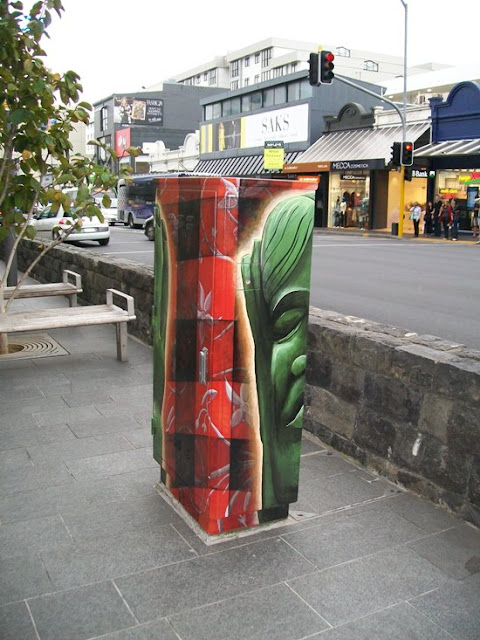This week, I went looking for Jasons secondhand bookstore, which has moved from its former site on Lorne Street to O'Connell Street. While wandering around a bit in the Chancery Street area, I spotted the building in the centre of the above shot. Thinking how beautiful the lines looked -- and how odd that it was different storeys -- I photographed it, and thought I'd have a bit of a Tim espanner look at its past.
Jasons turned out to be across the road from the building. It was told that it had been a nightclub at one stage, and had caught fire. But, even though badly damaged, the owners pulled off a good restoration. Now, there's retail on the ground floor ... and I think (according to Google) a gay and lesbian bar.
But, as I found out -- that isn't all there is to 15-21 O'Connell Street, just up from Vulcan Lane.
This area is part of Lot 5, Section 4 of the City of Auckland as sold by the Crown in 1842 -- a long section that went to Moses Joseph, the only Jewish merchant to buy land at that sale, according to
Lazarus Morris Goldman in his history of Jews in New Zealand (1958). Between 1842 and 1864, Joseph's purchase was sliced up, Vulcan Lane and O'Connell Street cut through the property, and it became part of the generally residential, run-down
working class area of Chancery leading down towards Auckland's first beating heart of commerce, Shortland Street.
Around 1850-1851, Auckland gained from Otago one James Halyday who set up his furniture-making, undertaking and upholstery business in Princes Street, up on the hill.
Image: New Zealander 15 March 1851
Not long after, he'd secured a site on Shortland Street, but had a bit of bad luck.
FIRES.
On Saturday night about 11 o'clock, the inhabitants of the centre of the town were startled by the cry of " Fire !" proceeding from Chancery street. The Fire Brigade were upon the spot within five minutes with their engines; their services however, were not required, the fire being extinguished by some of the neighbours. On Sunday evening, about 9 o'clock, the cry of " Fire," was again raised in Shortland-street; a quantity of shavings in Mr Halyday's workshop, situated at the back of the premises, having taken fire, it blazed for a few minutes on account of the light material, but was happily subdued without the engines being brought into play. A sufficiency of praise cannot be given to the newly formed Fire Brigade, who were on the spot with their engines in working order, in a very short space of time after the cry was raised. As usual, immediately on the sounding of the fire bugle, the engine of Her Majesty's 58th regiment, on each occasion, was despatched to the scene of conflagration.
Southern Cross 27 March 1855
Fifty Pounds Reward,;
WHEREAS I have reason to believe that my' back premises were maliciously set fire to on Sunday night last. I hereby offer the above reward to any person who will give such information to the Inspector of Police as will lead to the detection and conviction of the Incendiary. James Halyday, Cabinetmaker- March 23, 1855.
Southern Cross 27 March 1855
He was a determined man, this James Halyday. He soon rebuilt, and was back in business, not even letting his hearing disability get in the way.
After the petty jury had been called Mr. Halyday applied to his honor to be exempted from serving, on the ground of deafness. His Honor replied that the proper time for making this objection would have been on the preparation of the jury lists by the clerk of the Resident Magistrate's Court; but that either the prisoner or the Crown might, on the jury being empanelled, object to him on this ground.
Southern Cross 4 December 1855
He was selling perambulators and venetian blinds from his Shortland Street store, warehouse and showrooms by 1862. Then, later that year, he saw an opportunity for extending his business' capacity: building a brick furniture factory in O'Connell Street.
Tenders for the erection of a building in O'Connel-street, will be received until noon of this day, by Mr. James Halyday, Shortland-street.
Southern Cross 6 December 1862
But Halyday ran foul of the local building regulations, dissuading folk from building in wood due to fire risk.
Breach or the Building Act.
James Halyday, of Shortland-street of the Building Act. James Halyday, of Shortland-street, was charged by Mr. Warner, with a breach of the 14th clause of the Auckland Building Act, 1858, by commencing to build without giving 24 hours’ notice to the appointed inspector, under this Act. Mr. Halyday admitted the offence, and was mulcted in the fine of 40s. and costs.
Southern Cross 24 December 1862
BREACH OF THE BUILDING ACT.
James Halyday, upholsterer. Shortland-street, was charged, on the information of Horatio Nelson Warner, Inspector of Buildings, that although served with a notice as required by the 7th clause of the "Auckland Building Act, 1858," he had not complied with the same, but still continued to carry on the building alluded to in the said notice, and contrary to the provisions of the said "Auckland Building Act, 1858" ...
Horatio Nelson Warner deposed - I am the complainant in this matter. I am the person appointed by the Superintendent as inspector of buildings, under the Building Act, 1858. I received this letter (produced) from Mr. Halyday notifying his intention to build. Subsequently to that Mr. Halyday proceeded to erect a building in O'Connell-street of which I now complain, as not being in accordance with the Building Act. I produce the Building Act ...
In consequence of Mr. Halyday proceeding with this building, I served him personally with the notice on the 24th of January, in Queen-street.
Notice read as follows :—
" I do hereby give you notice that the building now in progress under your orders, situated in O'Connell-street, is not conformable to the 23rd clause of the Building Act 1858, in the portion thereof undermentioned. The entire frame is constructed of wood and you are hereby required within 48 hours from the date hereof to amend the same.
Dated this 24th day of January, 1863, at the hour of 10 o'clock a.m.
H. N. Warner, Inspector of Buildings."
The building I complain of is not in accordance with the 23rd clause. The whole of the frame is constructed of wood; the only exceptions in the clause for wood, are windows, skylights, and doors. I believe the building I complain of to be the one Mr. Halyday is erecting in pursuance of the notice he gave ...The building has gone on since the notice, and he has increased the building, though he has not deviated from the principle of the instruction. There is much more wood-work in the building than is usual in iron houses of that dimension, taking it proportionately, although I gave permission. I told Mr. Halyday that I thought the building would be objected to on the score of there being too much timber. The foundation and eleven feet upwards is masonry. What I complain of is the superstructure on the masonry. I have seen Mr. Halyday standing on the premises, but have not seen him taking any part in the building, or giving any instructions. He gave me the notice. I do not know Andrew Clow, or that he has been building the house ...
Southern Cross 4 February 1863
Once Andrew Clow, the builder, returned from the Wade (Silverdale district), the case continued, but was also speedily resolved.
This case was resumed this morning by the examination of the contractor. Mr. Wynn for the prosecution; Mr. Merriman for the defence.
Andrew Clow, examined by Mr. Merriman. Deposed: I hold in my hand a contract entered into between me and Mr. Halyday for the carrying out of certain works in O'Connell-street. I am the person performing the work under that contract. I am erecting the building for Mr. Halyday. I am constantly, from time to time, on the premises carrying out that work. The contract refers to the whole work above the stone and brick work. That is the specification (produced) by which I contracted, and by which I worked, with a few alterations. I deviated from the specifications in consequence of instructions I received to make the building conformable to Mr. Warner's instructions.
Cross-examined: I was merely to perform the work. Mr. Halyday finds the material. I have performed the work. I pay the men.
Mr. Wynn then gave up the case, which was accordingly withdrawn.
Southern Cross 7 February 1863
Andrew Clow seems to have arrived in Auckland 1859. He also built the industrial school on Howe Street (Ponsonby Park) when it was altered to become immigration barracks in September 1864, as well as Wellington Street Presbyterian Church March 1865, but went bankrupt in 1867.
Halyday extended his business further, by buying up the Waipareira Sawing Station in West Auckland, with land, buildings, and 2,000,000 feet of timber, two miles from Prior’s Landing, for £250 in May 1864, and provided furniture and fittings for Vialou’s Auckland Hotel in November the same year.
Come February 1865 – another Shortland Street fire burns down Halyday’s business there. At that stage, he and Mrs Halyday had eight children and a servant.
“So rapidly did the flames spread that some of the inmates of this house were compelled to seek shelter in the street with only their night-clothes on ; and the consternation of the bystanders and the family was very great when it was found that two of the children were missing. Further search was made on the premises, but no traces of their whereabouts could be discovered. Later in the morning, however, the missing ones turned up, to the great comfort of the parents. The goods in the front building were mostly conveyed from the shop to the neighbourhood of the workshop in O'Connell-street.”
Southern Cross 16 February 1865
But, he still had his O'Connell Street factory, of course. He was undertaker for the funeral of Rev. Mr Morgan of Otahuhu in June 1865, and had rebuilt his Shortland Street showroom in brick by September that year. He was a member of the Auckland Land Society in 1865.
“A large reserve stock of furniture is kept in the factory in O'Connell-street, where a number of workmen are constantly employed.”
Southern Cross 27 October 1865
In March 1867, he was one of the three undertakers for Mrs Thomas Henderson.
In February 1876, his Shortland Street warehouse burns down yet again. And still, he rebuilds. 26 Shortland Street, site of his warehouse and later known as Halyday’s Building from the 1890s, is now demolished and is a car park between Shortland Street and Fort Street.
In anticipation of the early arrival of Sir Hercules Robinson to assume the Governorship of this colony, the Government has ordered the renovation of the Auckland Government House. Mr. Halyday has been ordered to execute the requisite work in the way of upholstery, carpets, &c. The building, in respect of upholstery, is to be entirely re-furnished.
Hawke’s Bay Herald 3 February 1879
I paid a visit to the Lunatic Asylum on Saturday and found everything going on well. The new wings are nearly ready for furnishing, and Mr Halyday, the well known upholsterer of Shorthand Street, was engaged measuring the various rooms, cells, corridors, &c, with a view of an estimate for the requisites needed.
Thames Star 16 November 1880
By the 1890s, the business was known as Halyday Brothers, most likely his sons. They dissolved partnership and retired from the business in June 1892, 40 years after James Halyday began trading in Auckland, selling to the Auckland Furniture Company Ltd. James Halyday junior was appointed as Registrar of Electors for the City of Auckland in August 1893, and therefore was the registrar to handle the first election where women could vote.
James Halyday's fate in old age and retirement was a nasty accident in 1899.
At the departure of the [Boer War] contingent from the Auckland railway station an old colonist named James Halyday, aged 74 years, was knocked down by a 'bus. One of the wheels went over one of his legs and broke it. A boy also got injured, a cart going over his foot.
Evening Post, 10 October 1899
He was reported as making a good recovery by early November, but he died 5 September 1900.
A year before his accident, in 1898, Halyday finally relinquished his brick factory on O'Connell Street, according to ratesbooks in Auckland Council Archives records, to Oswald Robert Younghusband (c.1855-1923), who was apparently a shipbroker, and involved with patents for better ways to deoxidise ironsand (co-patent in 1890). Younghusband may only have been one of the members of the James Halyday Trust, however; this trust is noted in the valuation field sheets (also at Auckland Council Archives) as being the owner right through to 1919. From 1898, however, the building was leased by printer and publisher Arthur Cleave, who then bought it and owned it until his death in August 1933.
In 1910, he added two storeys to the southern end of the building, and an additional storey to the rest in 1929, forever changing the building's appearance. In 1931, there was a permit for reinstatement of printing works here, so Cleave was conducting at least part of his main business on this site.

The brick building in 1900. Image: DP 2647, LINZ records, Crown Copyright.
Southern end of the building.

Mr. Arthur Cleave, a well-known Auckland business man, died this morning after a short illness. He was born in London 71 years ago, and came to New Zealand with his parents when two-years old. Mr. Cleave was the first cadet appointed in the railways on the Auckland line, and afterwards was confidential clerk to the late Mr. A. V. Macdonald in the Auckland office. He had risen to the position of stationmaster at Remuera when he retired in order to start business on his own account.
In 1889 his first venture was the "A.B.C. Guide," and afterwards he secured a contract to advertise on hoardings at railway stations. He subsequently issued "The Auckland Provincial Directory" and "The New Zealand Bradshaw Guide," and "New Zealand Illustrated Magazine," and purchased the "New Zealand Sporting and Dramatic Review," as well as more recently "The Pictorial News." Mr. Cleave also founded the "New Zealand Motor Journal."
He was one of the pioneers of motoring in Auckland, his car being No. 1. He made the first motor-car record for a run between Auckland and Rotorua, and the first trip by motor between Auckland and Wellington, the vehicle used being a steam locomobile car. He was long ago elected a life member of the Auckland Automobile Association, for which he was honorary secretary, for some time. Mr. Cleave founded Wairakei Limited, which acquired Mr. Graham's property near Taupo. He was managing director of A. Cleave, Ltd., and a director of the White Star Co. and Wairakei Ltd.
Mr. Cleave is survived by his widow and six children.
Evening Post 4 August 1933
Cleave's property went to the Guardian Trust in 1934, and under their ownership architect A M Bartley designed "renovations and structural alterations to premises O'Connell Street for the Perry Trust" in March 1937, according to Council records. If that was for this building, it could explain the Art Deco era lines to the whole facade.
In 1945, the property was sold to company director Arthur Joseph Hutchinson, and the valuation field sheets refer to the Boy Scouts Association at that point. Then another sale in 1946 to Mooneys (NZ) Ltd of Auckland, then a further sale in 1953 to British Trader Insurance Company (they'd leased the building from 1947), a name now forever fixed to the building after another renovation by architect Lewis Walker in 1953. Since 1966, there have been a number of owners.
Since then, it has also been known best for its nightclubs. Here are some of the names over the years:
Jilly's Cabaret
Retro
Retro Nouveau
Spurs
Steps
The Casino Club
Stilettos
and lately, the Flesh Nightclub & Lounge Bar.
As I mentioned before, though, there are fashionable retail stores on the ground floor. This one has an antique sign which I doubt is original to the building, somehow. Please do point out that I'm wrong, though.
So, here it is. I don't think Hallyday's other building, aka the British Traders Insurance Building, aka 15-23 O'Connell Street, is scheduled on the district plan, and it doesn't seem to be NZHPT registered. Sure, it looks like a mid-20th century landmark, but perhaps, underneath the additions and alterations, it still has her 19th century 1862/63 core. Hopefully, someone will take a good look.




















































